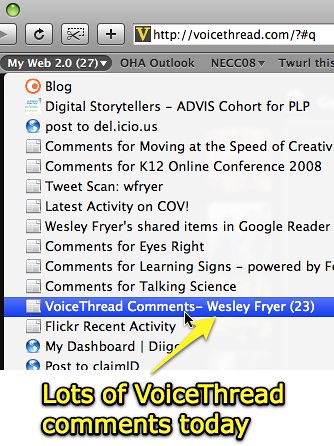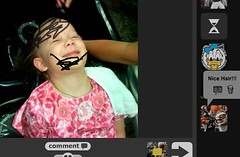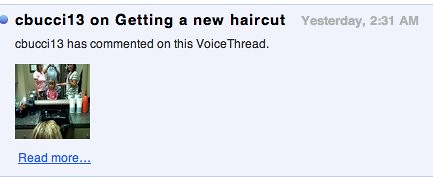Here in the United States, we live in a relatively free society compared to some other nations. North Korea and China come to mind first in this regard, but there are many others too where individual freedoms are more sharply limited and restricted. I highly value and treasure those freedoms, and try not to take them for granted.
Online, learners young and old often have a great deal of freedom as well. I think this is an inherently good thing. User-created content (UCC), also known as User-generated content (UGC) or consumer-generated media (CGM), allows degrees of freedom which often make teachers, principals, and other traditional caretakers of students in schools very uncomfortable and nervous. The basic reason for this, in my view, is that schools are typically organized to support the value of CONTROL over the value of FREEDOM. Digital technologies, and the Internet in particular on the other hand, tend to support the reverse: Freedom over control. This tendency is something Robert Bork identified in his book “Slouching Towards Gomorrah” several years ago, when he quoted another author (whose name I don’t recall, unfortunately) who observed that “technology tends to be on the side of anarchy.”
This is a philosophic way to begin sharing a few reflections on the subject of virtual vandalism. Virtual vandalism is, of course, not new and I think it’s here to stay. It’s a part of life in a free society and on a relatively free Internet. (Barring many K-12 school networks, of course.) The fact that learners of any age can use digital communication tools in constructive or destructive ways should be at the heart of many conversations in our homes and classrooms about digital citizenship and ethics.
Before sharing the examples below, I’d like to preface my comments with several important observations.
- I love the web-based, interactive digital storytelling environment which is VoiceThread. I am not affiliated or financially connected/renumerated in any way by VoiceThread, my passion for using this tool and sharing it in presentations and workshops comes strictly from the great value I think this environment has for learning and interactive communication.
- The VoiceThreads I have created along with my own children and others I’ve helped in workshops over the past couple of years have been commented on by hundreds of people. Amidst these comments, VERY, VERY few have been negative or objectionable. When I have contacted VoiceThread staff about a concern, they have been quick to respond appropriately.
With those statements in mind, I’d like to share some reflections about an example I think points to our need to encourage constructive media creation in our schools and homes. Yesterday and today, for some reason VoiceThreads on my account received many more comments than usual. This Safari RSS bookmarks bar screenshot shows 23 new VoiceThread comments for today. There were actually a few more which I viewed today before deciding to record a screencast and post these thoughts:
Students and learners in general are so UNFAMILIAR with the experience of creating and authoring content online, in many cases I think, that the opportunity to “scribble” on a VoiceThread digital story strikes them as a fun, funny, and desirable experience. This is a screenshot of one of the comments I deleted this evening from my then-3 year old’s VoiceThread, “Getting a New Haircut.” This is a very popular VoiceThread online, showing up (currently) on the first page of results when you click “Browse” on the VoiceThread homepage. Since I still have comments open for this VoiceThread, sometimes people like to scribble as this person has:
My first thought is that parents and teachers should turn kids who want to do things like this on VoiceThread loose for hours on TuxPaint, a free / open-source drawing and painting program for kids. There kids can scribble to their hearts content!
Of course one of the most exciting and attractive things about the Internet today and the social web is the fact that what we do can be seen by others, so the experience of drawing on a private, non-web-based drawing on TuxPaint is likely very different than the experience of being able to comment and potentially vandalize a VoiceThread digital story created by someone else.
There is another thought which comes to mind when I see virtual vandalism on a site like VoiceThread, however, which is the point I want to strongly emphasize in this post. We need to encourage and guide our children and students to constructively use their powers at the keyboard rather than destructively hurt or vandalize. I recorded a 3.5 minute screencast this evening and uploaded it to YouTube using SnapZ Pro X to demonstrate and discuss this idea, in the context of a recent VoiceThread comment my son’s “Washington DC Experiences” VoiceThread attracted.
This is the description of the video screencast I posted to YouTube:
This is a brief reflection on something which is inevitable with user-created content: virtual vandalism. I believe as educators we need to provide opportunities and guidance for students in the constructive uses of media, so they can channel their creative energies in edifying and beneficial ways. Of course it’s ultimately up to individuals to choose how to act, but we should try to guide them toward constructive commenting as well as content creation.
I am not whining or complaining about relatively harmless comments like this on VoiceThread. I do want to make the point that we need to give kids more opportunities to constructively create and share media. This is a key element of our statewide “Celebrate Oklahoma Voices” oral history and digital storytelling project. We need more projects like this in our schools and communities.
If you are a teacher connected to any of the students who left any of these scribbled or rude VoiceThread comments, please DO NOT interpret the message of this blog post as a request or suggestion that you stop using VoiceThread! Quite to the contrary!
Rather than stop the conversation, I encourage all teachers to use situations like this as teachable moments to discuss the importance of representing ourselves and our schools/organizations positively on the open web. We also should discuss the real effects our words, drawings, and actions can and do have on others with whom we share them.
Let’s take the need for conversations about digital citizenship, safe digital social networking, and cyberbullying prevention seriously. If you don’t start the conversation with your children and students, who will?
Internet users as well as cell phone owners have TREMENDOUS powers literally at their fingertips today. Just as the holder of the keys to this sports car could choose to make wise or foolish choices, we all can do the same at the keyboard or on our cell phone.
What are we going to choose to do with the amazing powers at our fingertips today?
Technorati Tags:
vandalism, vandalize, voicethread, ucc, user, created, content, school, technology
If you enjoyed this post and found it useful, subscribe to Wes’ free newsletter. Check out Wes’ video tutorial library, “Playing with Media.” Information about more ways to learn with Dr. Wesley Fryer are available on wesfryer.com/after.
On this day..
- Embed Twitter Widget in Dot Net Nuke (DNN) Website – 2015
- Disadvantages of Openly Sharing Media – 2014
- Yukon Students Learning Computer Programming with Scratch – 2013
- Introduction to the Common Core State Standards by Karen Robertson – 2012
- An Iterative Google Search (with advanced options) solves a MS Word File Saving Problem – 2012
- Learning about Glass Blowing in Santa Fe, New Mexico (videos) – 2011
- Good Memories from Denton and UNT – 2011
- Virtual DNA Fingerprinting Lab (1 to 1 Learning in Yarmouth, Maine) – 2011
- Brainstorm & Find Available Websites with DomainStorm – 2011
- Getting Creative with Windows Live Movie Maker on a Netbook – 2010





Comments
12 responses to “VoiceThread Vandalism and our need to encourage constructive media creation”
Hi Wes, I love Voicethread but don’t usually allow general comments on them. (When I allow comments they are private threads for specific groups.) I am so sorry to see this misuse of an amazing, virtually free tool. I wonder if it is really teachers who are allowing the ‘vandalism’ or just random Voicethread visitors? It is difficult to handle the misuse when it takes so long to have any of this approved by our schools. I love Voicethread and have been using it since it emerged. I wouldn’t have imagined this, but perhaps I should have. Again, the concept of internet etiquette and digital footprints remain topics to discuss in our classrooms.
I can’t believe I didn’t know about VoiceThread until this minute. I’ve heard people talking about it, I guess… but I never saw it. Now, to see if I can sell it at my district for use in my classroom. I hope they have a sheltered version.. that would solve SO many problems.
I just finished reading 13 Reasons Why, Jay Asher’s young adult novel narrated, in part, by a girl who creates a series of audiotapes explaining thirteen reasons which contributed to her choice to end her life. She leaves the tapes for a list of people (who must listen to and pass along the tapes to the next person on the list) who played a part in her suicide.
As an English teacher, I agree, it is vital we strive to instill empathy in our students–to at least have discussions about the power of our actions and words and their effects on others. Including, in such discussions, our actions on the web should be a part of this discussion. Asher’s book along with examples like the one you offer here could be a could starting point with students for such a discussion.
Audrey: I’m so glad you learned about VoiceThread! It is the first place I recommend teachers start with digital storytelling. VoiceThread does offer “VoiceThread for Education,” which is an even more accountable environment with parent-child relationships between teacher and student accounts. That means if a student does something like I’ve described in this post, it is even easier to identify and find that student. There is ACCOUNTABILITY in the system. I need to emphasize, however, there is accountability now in the public/non-education version of VoiceThread too. Each user account is traceable and “known” by the VT admins. You can link to info about EdVoiceThread on:
http://ed.voicethread.com/
Audrey: Definitely check out the “Voicethread 4 Education” wiki, which has lots of links to great classroom-created VoiceThread examples:
http://voicethread4education.wikispaces.com/
Thanks Wesley,
I’m checking it out now and sending it on to my tech director.. maybe she’ll go for it.
Wes,
A few weeks back, I spent a few days in a 5th grade class helping them with incredibly awesome VT project that involved a class in Illinois (we are in FL). It is an extensive project and obviously, the first day of the actual VT lesson was on using the app itself. I was in the room with the teacher, so you can rest assured that responsible commenting WAS discussed when explaining that their comments will be reaching out to the public and to real human beings who have published hard work and are hoping others will engage in the conversation.
These students have their own (paide) student accounts with the ability to comment anywhere on VT. We encouraged the students to check out “Getting a New Haircut” and “Washington, D.C” as they will be going to Washington, D.C., soon as a class. Now, they were in a lab setting all exploring simultaneously. Obviously, if we saw a student leaving an inappropriate comment we handled it, but it really was impossible to monitor completely because it was not our thread. If comment moderation was on, even more of a problem for us to see on our end. However, kudos to you, if comment moderation is on. I have requested from VT a feature that would allow teachers to see where their students have commented anywhere on any VT around the web (with a feed, like how Ning updates when new comments are made. They liked that idea a lot.)
So, as you posted about this incident, my palms were getting a little sweaty thinking it may have been one of those students. I checked and I did see one (Lindsey) and her comments were lovely. She did mark up the photo but only to make her point. I’m confident that is not what you were referring to.
My point is that digital hygiene is a 2-way street. When people post items on the web, they need to take precautions to prevent vandalism by using tools that allow for comment moderation, backtracking, revealing history, etc. Your example is GREAT to show what else might be lurking in an open digital world for our students. And although we ALL spout openness for all students everywhere, teachers need to think carefully about what they ask for and how they will manage it.
I’m saddened that you used VT as an example, because although you say otherwise, It may scare educators (who may not understand how the VY comment moderation works) away from using the tool. “The jury will disregard those comments?”
I am also not affiliated or financially connected/renumerated in any way by VoiceThread.
Lee: I agree it is a danger posting a criticism about VT because people may form their entire perception based on this single post, but I have to hope they’ll read further and learn what a GREAT, wonderful and powerful environment VT is for digital collaboration and learning.
VT is a digital learning environment in which I’m heavily invested in terms of time and experience, so it is naturally going to be one that I’ll reflect on. I think it would be disingenuous of me to only comment on the positive experiences I’ve had with it and I’ve seen. More often than not, I think we learn more from mistakes and bad experiences than from good experiences or lessons that go completely smoothly without any hiccups.
As I mentioned, the VT folks are very responsive to suggestions and requests for help, and I think that’s great. Your idea of permitting teachers to see the comments their students have left around the VT world is a great one. As I mentioned, I think this sort of things is inevitably going to happen in the free world that is the web. Interestingly, I’ve noticed that some of the VTs with more views are now locked from additional commenting. I like that VT provides a robust menu of options for sharing and moderating comments. VT is the closest thing I’ve seen to date to an ideal platform for asychronous communications. YackPack is another tool that I really like, but it doesn’t have the photo and video options of VoiceThread.
Kudos to you for using VT with your students and talking through these issues. Hands-on content creation with media and ongoing dialog about the issues which surround media creation as well as consumption are the best ways forward, in my view, to address these issues meaningfully.
Holding the creator of a work responsible for vandalism of that work reminds me of an absurd law in Quebec that fines car owners for causing car theft. If YOU leave your car unlocked in a parking lot in Quebec.. YOU get a ticket because by leaving it unlocked you created the temptation to steal. How’s that for backwards thinking?
I really couldn’t disagree more.
We want interaction…. interaction with other students, interaction with a text or other media. One of the risks of interaction is that some children will act inappropriately. It is to be expected. Isn’t it just the classroom extended outwards? So, they misbehave. Best solution: Teach appropriate conduct, set expectations and clear consequences, monitor your students(particularly at the beginning of using a new tool), require them to interact through an identity that can be followed and hand out consequences where needed.
I would never ask another teacher to moderate all interactions with their students’ work because I know how time consuming that is. In student blogs, for example, if I moderated all entries and comments(as opposed to monitor), I would have to go to the back end, wait for an individual blog to load, read the entry or comment, accept or reject it, wait for the action to load, do that for each entry and comment on that blog, then go to the next blog in the back end, wait for that blog to load and do it all over again, times 20 blogs. You see my point. I couldn’t continue to blog in the classroom under that circumstance. Therefore, every blog and comment goes up and either goes to my feed or to my email. I read it there and decide whether I need to go to the blog back end or not. My students absolutely get consequences for inappropriate behavior and I run a pretty tight ship, but I try to remember to lighten up (inwardly) about them doing inappropriate things. It happens… I follow up. Enough said, enough done.
Audrey: I think you may misunderstand me. My position isn’t analogous to the Quebec car theft situation– I’m not saying that teachers should be the gatekeepers of ALL the content their students create. I agree with you, that would be ridiculous from a time standpoint, and also be counterproductive potentially to the goal of helping students become good decision-makers autonomous of adult control. I think we should be in conversation with students about these issues, but recognize that, yes, they DO and SHOULD have the power to create and share comments as well as original media works without adult intervention.
It sounds like you’re doing a great job helping your students learn the issues involved with user generated content, and you’re there providing consequences at times when they are warranted. So I guess I’m not following what part of my position with which you “couldn’t disagree more.” Can you please clarify? I think what you’re doing sounds great. I’m not arguing that teachers should make every effort to avoid any type of virtual vandalism like that discussed in this post. I AM suggesting we need to keep talking about these issues, and encourage students to make constructive choices. Obviously we can’t guarantee they will make those choices all the time, if they are continuing to have access to the web to create and publish– two things I believe they SHOULD be permitted to do.
Actually, I thought I was defending your position when I disagreed with one of Lee’s comments, “When people post items on the web, THEY(emphasis added) need to take precautions to prevent vandalism by using tools that allow for comment moderation…”. It puts the onus on the creator to protect his work, which seems analogous to holding the car owner responsible for the actions of the car thief. Not only does it confuse responsible parties but, in my experience, is unworkable.
He later talks about using backtracking and revealing history to identify the person making the offending comment. I agree with that. I think that it is a key solution, and from my perspective, the most reasonable all around. If every child knows that a digital trail follows his actions (through sign in or computer signature) he is more likely to consider those actions carefully.
Audrey: My bad! Sorry. I’m guilty of not following all the comments on the thread… sorry.